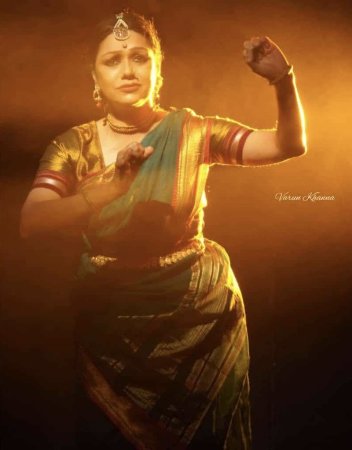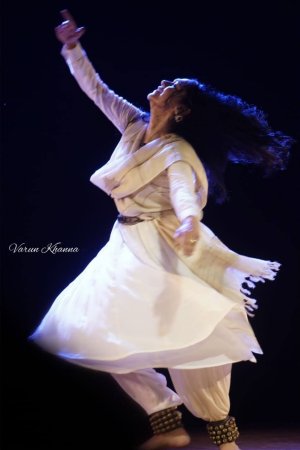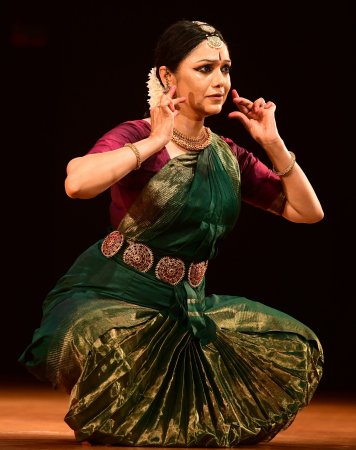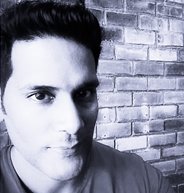
|   |

|   |
Art to nurture body and spirit - Jeetendra Hirschfeld e-mail: sathirdance@gmail.com Images courtesy: Varun Khanna and Madras Music Academy February 7, 2024 I vividly recall my first encounter with Rama Vaidyanathan at the Royal Tropical Theater in Amsterdam in September 2001. This performance holds a lasting memory as it took place shortly after the New York attack that reverberated worldwide. Before her performance, Rama graced the stage with a heartfelt address, contemplating cancelling in light of the recent events. However, she expressed the belief that art nurtures both body and spirit, offering a temporary escape from the troubles of daily life. The distinctiveness and originality of her performance, coupled with an indescribable quality, left an enduring impression on me. Since that evening, I have prioritised attending Rama's performances whenever possible. December 25, 2023 - "Mad and Divine" On Christmas evening, Rama graced the Krishna Gana Sabha with the reprisal of her dance-drama production "Mad and Divine", marking its return to Chennai after 12 years. The choreography tells the tale of two extraordinary women: the 13th-century Sant Janabai, the Marathi poet, and the 14th-century Lal Ded (Lalleshwari), the Kashmiri poet-saint. Both women, driven by their devotion to the supreme, endured hardships before finally being recognised.  Rama as Janabai (Photo: Varun Khanna) The production, initially commissioned by Dr. Anita Ratnam for the Natya Darshan Conference in 2011, marked a significant milestone in Rama's artistic journey. Crafting an original dance production centred around female poets not commonly featured in Bharatanatyam posed a considerable challenge. From conceptualisation to execution, the journey demanded extensive research into the lives and works of these poets. While familiarity with the Abhangs of Janabai presented fewer obstacles, delving into the Vakhs of Lal Ded required in-depth study. The poems of Lal Ded are some of the oldest in Kashmiri literature, requiring Rama to thoroughly explore these ancient texts and collaborate with Kashmiri scholars for transliteration and translation. Only after this groundwork could the interpretation of choreography begin. Since its debut, "Mad and Divine" has captivated audiences worldwide. Rama persuasively depicted Janabai, adorned in a saree that embraced the unique Maharashtrian fashion, as a maidservant in the household of Damasheti, the father of the religious poet Namdev, who lived in Pandharpur. Surrounded by this sacred atmosphere, Janabai underwent a profound metamorphosis, becoming a passionate worshipper of Panduranga Vitthala (Lord Vishnu), ardently yearning for divine acceptance. In striking contrast to the first act, in the second act, Rama portrayed Lal Ded clad in a simple white churidar kameez adorned minimally and with her hair flowing freely. Her portrayal aimed to depict Lal Ded's quest for divine enlightenment through the union of Shiva-Shakti, striving for heightened consciousness through Kundalini. Consumed by her devotion, she sheds her clothing, casting off every trace of her ego. The transition between dances in both acts was seamless, with Rama herself delivering the live narrative. Her impeccable breath control during these moments caught my attention.  Rama as Lal Ded (Photo: Varun Khanna) A musical ensemble of outstanding artistry supported the choreography. Sudha Raghuraman vocalised the poetry (and composed the music for "Janabai"), the nattuvangam was by Dr. S. Vasudevan (also an accomplished vocalist and dancer, composed the music for "Lal Ded"), the mridangam was by Sumod Sreedharan, flute by G. Raghuraman, and light design by Sushant P. Jadhav. This intense collaboration between the dancer and musicians has resulted in the distinctive flavour of the music. Rama opted to reprise "Mad and Divine" as the curtain raiser for the 41st Natya Kala Conference, where she served as the convenor for the third time. The conference, aptly titled "TranscenDance", commenced the following morning. As I journeyed home after the performance, I pondered: which one of these women embodied divinity, and which madness? Or were they transcending to encompass both "Mad and Divine"? January 7, 2024 - Margam The collaboration between Rama and the musical ensemble continued for the Music Academy Dance Festival, featuring a Margam with four carefully chosen dances. It commenced with "Sringara Rasamanjarim", in which Muthuswami Dikshitar reflects on the beauty of Goddess Kamakshi, likening her to a cluster of blossoms that are always in bloom. Those seeking refuge revere the goddess as the wish-fulfilling creeper, capable of mitigating the adverse effects of the nine Grahas. She is also celebrated as the bestower of well-being and good fortune, pleased by the seventy-two Raganga Ragas. After a one-minute prelude (raga rasamanjari) by flautist Raghuraman, the piece unfolded gradually, developing through measured vocalisation to build up the song. It allowed the dancer to layer expressions and combinations of adavu patterns in tisra ekam. Each repetition of lyrics was followed by a period of almost stillness, complemented by sensitive lighting, creating a sense of tranquillity. Rama poetically danced the composer's verses with equal grace. The 18th-century composer Pachimiriyam Adiyappa immortalised himself through his varnam in Bhairavi. Adiyappa flourished in the Tanjore court of Maharajah Pratap Simha (r. 1739-1763), and (according to my guru) he wrote the varnam with the famous courtesan and poet Muddupalani in mind, praising her as Viriboni. The varnam, a signature composition of the iconic Yamini Krishnamurthi, was passed down to her disciple Rama at just 16. Since then, Rama has maintained a close connection to Viriboni, presenting her reimagined versions over the years. Similar to the opening dance, the flautist introduced the ragam. While time constraints in Bharatanatyam performances have largely eliminated preludes preceding each dance, I prefer these short 'breaks' as they help prepare the mind for the next dance. In the varnam, the Sakhi addresses Lord Rajagopala of Mannargudi. She tells him: "My friend, the flower-like beauty desires only you. Oh, ruler of the Cowherd tribe, my handsome Rajagopala, the amorous one of Dakshina Dwaraka, please protect my friend, the one with the radiant, smiling face, Viriboni, who is overflowing with passion." Continuing the flower-like metaphor from the opening piece, Rama drew parallels between a flower and the Naayika, depicted through a sanchari portraying the seed of a lotus blossoming into its full splendour, followed by the subsequent disintegration of the petals, metaphorically describing Vipralambha. Through the sorrow of Vipralambha, the dancer beautifully explored transient feelings of longing, distress, and restlessness, vividly suggesting the separation of the lovers. In the anupallavi sanchari, the repeated invocation of Rajagopala accompanied by electrifying singing, garnered praise from the audience.  Image courtesy: Madras Music Academy In the poem of Rabindranath Tagore, the protagonist implores, "O je mane na mana" The night has passed, and it is time for you to leave. Why do you ignore my plea? Instead, you adamantly refuse, saying: no, no, no! Though it is time for you to depart, you stubbornly stand before me, refusing to budge, your passion evident in your unwavering gaze. Rama's interpretation of this exquisite poem was intense and light-hearted, evoking smiles from the audience as they recognised the relatable dynamics of passionate lovers. A group of women catch sight of a handsome, charismatic man, prompting one of them to inquire, "Who is this man?" Another woman responds, "He is the dancing lord, the saintly figure who reveals his divine dance in Chidambaram." Yet another woman adds, "Who is this man riding the bull?" To which another replies, "He is the magnificent dancing lord who once consumed poison to bestow nectar upon mankind." Excitedly, they exclaim, "There he goes, adorned with the crescent moon, our beloved dancing lord!" This scenario set the stage for the swara padam attributed to Muthu Thandavar, in ragamalika by Sudha Raghuraman, and the interpretation of the Tamil lyrics provided by Prof. Raghuraman. Rama's dance interpretation alternated between expressions and intricate adavu combinations for the swaras. Having observed Rama Vaidyanathan's artistry for over two decades, I consistently glean something new from each performance. Her art engages the audience, urging them to immerse themselves in the experience rather than passively comprehend it. Her art surpasses mere entertainment, instead offering nourishment for the spirit.  Jeetendra Hirschfeld is a Bharatanatyam artiste, writer, and researcher in dance history with special interests in Tanjore Natyam Art, Courtesans, and Royals. |